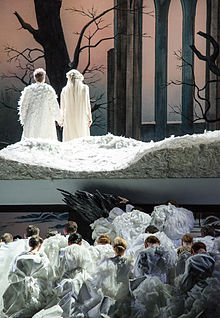
Back Lohengrin Afrikaans Лоенгрин (опера) Bulgarian Lohengrin Catalan Lohengrin Czech Lohengrin Danish Lohengrin German Λόενγκριν (όπερα) Greek Lohengrin Esperanto Lohengrin Spanish لوهنگرین Persian
This article needs additional citations for verification. (August 2020) |
| Lohengrin | |
|---|---|
| Opera by Richard Wagner | |
 Production of the Oslo Opera in 2015 | |
| Librettist | Richard Wagner |
| Language | German |
| Based on | Medieval German Romance |
| Premiere | 28 August 1850 |
Lohengrin (pronounced [ˈloːənˌɡʁiːn] in German), WWV 75, is a Romantic opera in three acts composed and written by Richard Wagner, first performed in 1850. The story of the eponymous character is taken from medieval German romance, notably the Parzival of Wolfram von Eschenbach, and its sequel Lohengrin, itself inspired by the epic of Garin le Loherain. It is part of the Knight of the Swan legend.
The opera has inspired other works of art. King Ludwig II of Bavaria named his castle Neuschwanstein Castle after the Swan Knight. It was King Ludwig's patronage that later gave Wagner the means and opportunity to complete, build a theatre for, and stage his epic cycle Der Ring des Nibelungen. He had discontinued composing it at the end of Act II of Siegfried, the third of the Ring tetralogy, to create his radical chromatic masterpiece of the late 1850s, Tristan und Isolde, and his lyrical comic opera of the mid-1860s, Die Meistersinger von Nürnberg.
The most popular and recognizable part of the opera is the Bridal Chorus, colloquially known in English-speaking countries as "Here Comes the Bride," usually played as a processional at weddings. The orchestral preludes to Acts I and III are also frequently performed separately as concert pieces.
The autograph manuscript of the opera is preserved in the Richard Wagner Foundation.
© MMXXIII Rich X Search. We shall prevail. All rights reserved. Rich X Search